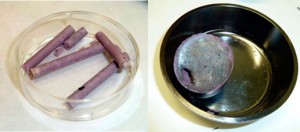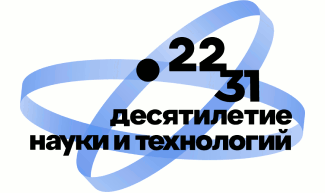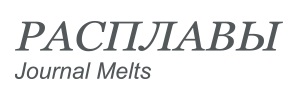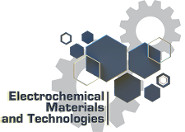Currently, scientists of IHTE UB RAS keep up to date with chief important scientific directions determined by the Russian government. So, In 2014, IHTE UB RAS took part in the Federal Target Program (FTP) competition “Investigation and development of priority oriented directions of scientific-technological complex of Russia for 2014-2020” organized by the Ministry of Education and Science. The competition’s results brought great success to IHTE UB RAS as the Institute won three applications at once for performing an applied scientific research. Subjects of investigations presented for FTP competition have a major importance for economy and industry development. Many large and well-known enterprises such as RUSAL, Rosatom state corporation enterprise, Gazprom, RPC Magnetic hydrodynamics, Krasnoyarsk Aluminum plant, Sosny research and development company, Sverdniikhimmash are interested in realization of work within a framework of FTP. That is to say, these enterprises participate as IHTE UB RAS industrial partners in three FTP projects:
- Development of current-leading anode assembly for Soderberg electrolyzer of JSC Rusal Krasnoyarsk
- Development of energy-saving method for producing aluminum, containing boron or scandium, with the use of molten salts
- Development of scientific-technical decisions for pyroelectrochemical spent nuclear fuel refining in closed fuel cycle of nuclear power installations with the use of molten salts
Novel technologies for producing aluminum alloys using molten salts
Fast development of Hi-Tech in such industries as robotic, vehicle manufacturing, aerospace and others as well as novel demand for exploitation of alloys are of great scientific interest, especially in the field of master alloys, alloys and composite materials. So, alloys of aluminum with scandium have a combination of unique properties: high durability, ductility, corrosive resistance. However, the usage of such alloys is very limited due to the high cost of Al-Sc master alloy. In turn, alloys of aluminum with boron possess higher electrical conductivity, good durability characteristics and can be used as a rather cheap hard-facing material. The Al-B master alloy applies also for refining aluminum from transition elements, increasing its purity and exploitation specifications. The Al-B master alloys production is carried out by several large world enterprises, and the information about the technology is very restricted. Now in Russia the Al-B master alloys are not produced. A very perspective direction for developing novel technology for producing aluminum-boron and aluminum-scandium alloys is a technology applying molten salts as a media. Decrease of the energy consumption and costs can be achieved due to variation in molten salt composition which possesses the better exploitation characteristics. This will allow reducing the temperature of the process as well as overvoltage of electrode reactions, and to increase the boron or scandium extraction from the raw materials and to organize one-stage continuous process.
Novel technologies for producing the aluminum alloys are developed in the laboratory of electrode processes under the leadership of Zaikov Yurii Pavlovich, IHTE UB RAS director, Doctor of Science (Chemistry), professor. The project “Development of energy-saving method for producing aluminum, containing boron or scandium, with the use of molten salts” (№ 14.607.21.0042 dated 21th August 2014) was supported by the Ministry of Science and development of RF in August 2014.
Investigation of phase equilibrium of the “potassium-sodium cryolite-scandium oxide” system, and mutual solubility of scandium and aluminum oxides in cryolite melts of different composition allow find the molten media for producing the Al-Sc alloys at temperatures as low as 750°C. The process developed by the IHTE UB RAS employees will be tested at large-scale lab experimental installation already in 2015.
The IHTE UB RAS scientists have significantly improved known aluminothermal method for producing Al-B master alloys by creation new compositions of molten salts-fluxes possessing better protection function and effective refining ability, low density, low melting temperature. The Al-B master alloy obtained with the use of new salt fluxes had the boron content in aluminum of 4% and its equal distribution through the aluminum matrix. In order to construct an experimental installation for the Al-B production the lab technological regulations and outline-constructive documentations consisted of furnace, magnetohydrodynamic rotator, conveyer and layer mechanism were also developed.
Together with the industrial partners RPC Magnetic hydrodynamics and Krasnoyarsk Aluminum Plant (RUSAL) and at their industrial sites the experimental installations for producing the Al-Sc and Al-B alloys are being manufactured according to novel technologies.
Technology of applying novel protective coatings on anode current-lead in Soderberg electrolyzer
Technologies connected with the aluminum production are of great interest as for research as for metallurgy industry. The method of electrolytic aluminum production is one of the most energy demanding, and RUSAL Company, OJSC is one of the main power consumers in Russia with the output volume of aluminum of 14-16 MWt/h per 1 ton.
Following one of the priority directions for science development in Russia, RUSAL improves technical solutions, the aim of which is to reduce energy consumption during primary aluminum production without deep modernization of electrolyzers and significant costs.
A great potential for reducing energy losses is concealed in modernization of current-leads, i.e. constructions responsible for current supply to the electrolysis bath. Being exploited as a part of the anode assembly in Soderberg cell at 900ᵒC, the anode current-leads, generally, have the operation time not more than 48 months, and nowadays, the operation life-time is even less, about 24 months.
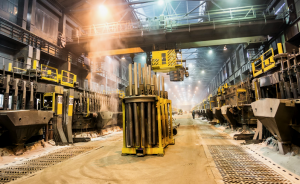
The Soderberg electrolyzers with top current-lead at “RUSAL-Krasnoyarsk”, OJSC. In the center is the asembly with the anode current-leads before installation into the bath
During implementation of the tasks designated by the project titled “Development of current-leading anode assembly for Soderberg electrolyzer of Rusal Krasnoyarsk, OJSC” (№14.607.21.0035 dated 5th June 2014) it was pointed out that a reduce of the anode current-lead resources is connected with the serum concentration in the carbon containing raw material, used for the anode production. An interaction with serum and formation of the iron sulfide layer on the surface of steel current-leads result in decreasing their electrical conductivity and increasing specific power consumption. Oxide-sulfide corrosion products, being in a bath, contaminate the aluminum.
The IHTE UB RAS researchers met a challenge during project realization, which consisted of providing a high electrical conductivity of anode current-leads and increasing their resources without reducing the quality of produced metal.
As a possible decision a protective corrosion resistance coating based on aluminum and methods of its applying with the use of molten salts was proposed. Melts based on aluminum fluoride with additions of alkali fluorides, which are using in technology of electrolytic aluminum production, have rather high solubility of metals oxides. This property was used in the developing technology for coating applying. An effective dissolution of the oxide films from the surface of steel current-leads allows increasing the coating quality, without using protective atmosphere, and reducing the quantity of technological operations.
In 2014, the first stage of the project was successfully completed: lab test study of corrosion resistivity of steel current-leads with protection coating in conditions corresponding to the conventional was carried out. It was revealed that applying aluminide coating with high quality provides multiple increase of heat resistance of steel-current lead in air and protects from serum corrosion. Currently, the preliminarily work are performing for testing in industrial conditions – at the RUSAL Krasnoyarsk electrolyzers. During project, a special installation of remote controlling the corrosion abrasion of current leads based on 3D-scanning of their geometrical sizes will be designed. This installation will specify the effect of applying experimental current-leads with protection coating.
Closed fuel cycle of nuclear power installations
Another scientific direction, interest to which grows significantly during the last few years, is investigation of molten salts as perspective working substance of nuclear power installations, media for refining natural raw materials, containing rare and radioactive metals, radionuclides, and other products of nuclear reactions. The development strategy for modern atomic energetics is based on principles providing essential safety of nuclear reactors; excluding accidents of radioactive products ejection into atmosphere; nonprofit regime, closing fuel cycle of atomic power stations; refining nuclear fuel and others. Salt, especially fluoride and chloride melts as no other liquid media (water and organic substances) having their unique properties (thermic and nuclear stability, high electro- and heat-conductivity etc) can be successfully used in atomic energetics as fuel compositions of liquid salt nuclear reactors, blankets, heat carriers, and regenerative media while refining spent nuclear fuel (SNF). They provide necessary conditions for creating atomic power stations with closed nuclear cycle (CNC), returning enriched nuclear fuel into fuel circuit, decreasing volumes of “long-life” radioactive fission products. These products are intended to be “buried”, that is why the factors dangerous for people and environment while exploiting nuclear power installations are excluded.
At the end of 2014, IHTE UB RAS won the project “Development of scientific-technical decisions for pyroelectrochemical spent nuclear fuel refining in closed fuel cycle of nuclear power installations with the use of molten salts” (14.607.21.0084 dated 31th October 2014). This project is performed together with State Scientific Center – Scientific Institute of Atomic Reactors, JSC; and industrial partners: “Sosny scientific enterprise” and “Sverdniikhimmash”, OJSC. The investigations related to this project are of great importance due to development of novel reactors of the “BREST” type with nitride-uranium-plutonium fuel. The pyroelectrochemical refining is included in one of the types of complex refining fuel. Currently, the analysis of scientific and patent literature was performed, the directions of complex investigations of physical-chemical properties, redox media, corrosion for constructive metal alloys was determined, the methods for spent nuclear fuel refining and modeling electrochemical processes in halide melts were chosen, series of experimental tests were performed.
Personnel of the molten salts lab of IHTE UB RAS achieved some brand new results necessary for successful project realization:
– synthesis techniques of pure chloride electrolytes-imitators, free from admixtures of oxygen-containing compounds and water, which are poisons at pyroelectrochemical spent nuclear fuel refining, were suggested and tested;
– The kinetics of interaction between nitride and working molten electrolyte was studied;
– Liquidus temperature, heat capacity and conductivity of melts containing compounds of uranium and rare earth metals were measured;
– The model of pyroelectrochemical refining for spent fuel of nuclear power installations in halide melts was created and calculations of heat, concentration, and electric fields in testing electrolyzer intended for spent nuclear fuel in chloride melt were developed.

From the lab cell to installation for pyroelectrochemical spent nuclear fuel refining in the closed fuel cycle system
Our industrial partners performed works for technical enquiry development as well as construction documentation in order to manufacture the experimental sample of installation for electrochemical processes diagnosis in halide melts.
One of the most important and useful results of the project implementation is an establishing direct business communication with “Rosatom” State Enterprise. These contacts help estimating the complexity of issues related to close fuel cycle of atomic power stations and specify the purposes on pyroelectrochemical refining of spent nuclear fuel technology.
All works are performed with financial support of the Ministry of Education and Science of Russian Federation according to agreement on subsidy assignment №14.607.21.0035 dated 5th June 2014 (RFMEFI60714X0035), № 14.607.21.0042 dated 21th August 2014 (RFMEFI60714X0042), № 14.607.21.0084 dated 31th October 2014 (RFMEFI60714X0084).

